RAILWAY OPERATIONS
Driving through the changes on the ECML CHANGE, MANAGING & THE SHARP END
In part two of his feature about driver Mick Ingledew of Newcastle, Fraser Pithie provides a further instalment of a railway career on the ECML that has spanned four decades – and is still going strong. The subjects of Sectorisation to Privatisation take the spotlight this month.
PART 2

A familiar scene taken midway through the GNER era on June 4, 2004, with Class 91 Nos. 91102 Durham Cathedral and 91126 York Minster waiting to work northbound services.
PICTURES: CHRIS MILNER UNLESS STATED.
FREIGHT had been the byword of Mick’s life for most of his time driving in the 1980s. In 1984, the Thatcher government had authorised BR to electrify the ECML. The work, together with a new fleet of electric locomotives (Class 91) and new Mk 4 rolling stock, came into passenger use in 1989.
The impact of recession and decline of traditional industries throughout most of the 1980s left Mick feeling by the end of the decade that the freight sector was destined to be a shadow of its former self.
By 1991 the scale of change taking place on Britain’s railways was growing by the day. The British Railways Board (BRB) sensed in the new Prime Minister, John Major, there was a willingness to go where his predecessor Mrs Thatcher had avoided. Consequently, the BRB decided to accelerate its programme of putting British Rail on a ‘business footing’ by sectorising its primary operations; the thinking being sectorisation would set things up well if privatisation of the railways came down the track.
InterCity had the highest-profile of the sectors, and was seen as the critical player in showing how the railway could operate as a customer-focused business.
Driver Ingledew’s analysis about the freight sector was proving right, and he exercised his judgement by applying to BR InterCity for a train crew leader (TCL) position at Newcastle. Mick got the job and started on September 23. There were more than 400 train crew based at Newcastle, with the senior drivers working to the Intercity link structure, and the remainder also working towards this. There were, however, drivers who preferred working the local services and chose not to progress to InterCity diagrams.

LNER driver Mick Ingledew.
PICTURE: FRASER PITHIE

Breakfasts on GNER in First Class were something to savour, and often served to passengers at speeds of up to 125mph.
Mick says: “Driver manager Terry Hutton, along with his personnel manager John Hannon, ran the depot very effectively, both achieving huge respect from their workforce.”
Before the introduction of the TCL role, there were just two traction inspectors: Colin Johnson and Neil Bainbridge. They were very busy as they also covered the 100 or so footplate staff at Tyne Yard. In the late 1980s training new drivers was in full flow, similar to what it was like in the 70s.
“The old method was about to be replaced with a more modern approach, as IT was becoming readily available, PCs with a DOS floppy disc and a whirring booting up, a sound I can still hear today!
“I had the pleasure of taking the final ‘MP12’ at Newcastle. Times were also definitely changing, with two female trainee drivers, Trudi and Lisa, who are both still driving Intercity trains today,” comments Mick.
Uncertainty
It was the early days of the 1990s and InterCity was to be short-lived with Privatisation looming. Once again, the effect of political change, so often a feature of railways since 1948, was felt again at the sharp end.
Mick sums up that period of uncertainty for so many: “There was a realisation a multi-sector reorganisation was stealthily occurring and straight away seniority determined your future with regards for ability, personal records or general motivation.
“At Newcastle we worked brilliantly as a ‘team’, with Colin Johnson at the helm and Alfie Gascoigne senior traction inspector guiding a largely young TCL outfit, but together it worked. At this time we split the TCLs into two teams, one InterCity the other Provincial/ Regional Railways, with a dedicated team of drivers, initially dictated through seniority and later through interview.”
“At one stage, a roster incorporated say six weeks of training and four weeks of ‘duty’ turns, where the former traction inspector role duties were prominent. This TI role was very varied and demanding dealing with routine safety incidents, and becoming more apparent, fatalities for which I’ve experienced many an aftermath, gruesome and awful, for the unfortunate driver and crew involved.